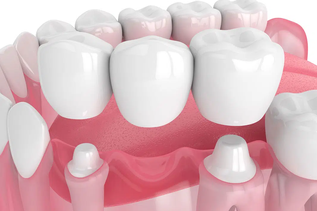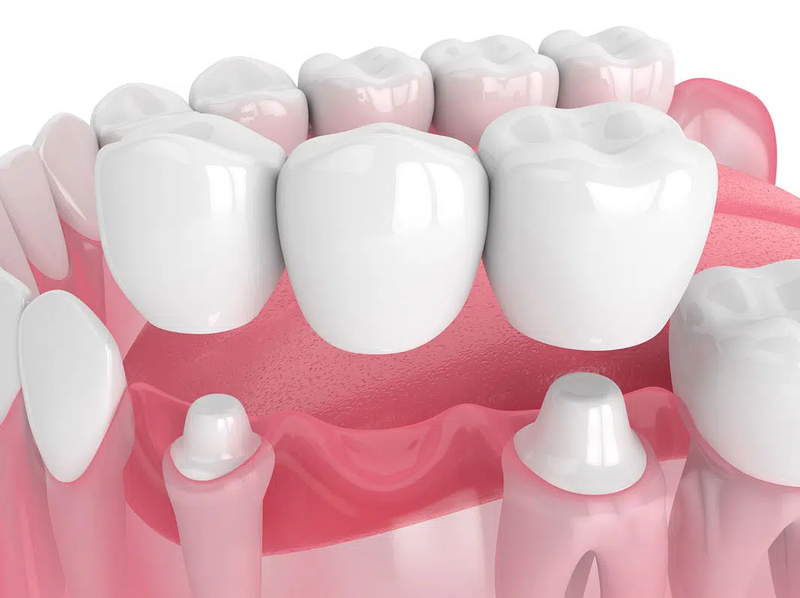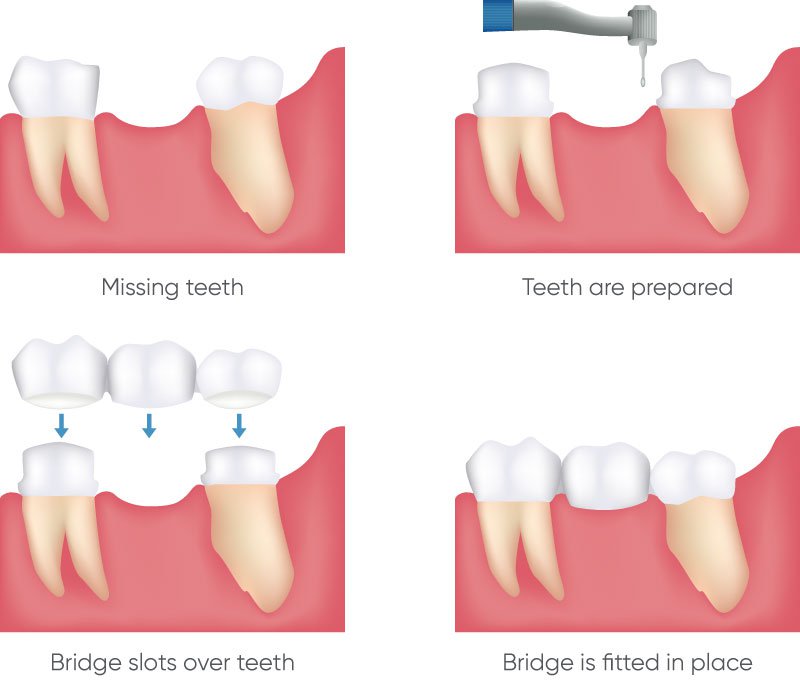
Dental Bridges: Everything You Need to Know
Adult human beings are designed to have 32 permanent teeth. But that’s not the case with many people. Tooth loss is not uncommon. You may lose a tooth or more to dental cavities, gum disease, injuries, or a chronic health condition. The loss of one tooth may trigger loss of more teeth as it may lead to gum shrinking and bone loss.
What is a dental bridge?
If you want to restore your missing teeth and smile, dental bridges are a fantastic option. Dental bridges are prostheses that are used to bridge a gap left by missing teeth. A false tooth is placed into the gap and fixed by cementing to the teeth on each side. A crown is then fitted on the top of it along with the adjoining healthy teeth. The bridge remains permanently fixed in the mouth. It is a convenient, cost-effective treatment for missing teeth.
Read on to understand everything about dental bridges, different types of bridges, the process of installing bridges, their benefits and aftercare.

Types of Dental Bridges
There are four types of dental bridge options for missing teeth. Your dentist will recommend the one that suits your needs and goals the most.
Fixed Dental Bridges
This section answers the questions – ‘Is a dental bridge permanent?’, and ‘What is fixed bridge teeth?’
This is the most common type of bridge used in teeth replacement. A false tooth (or pontic) is fixed with a dental cement to two healthy, adjoining (or abutment) teeth that are fitted with crowns. The bridge may be made of a biocompatible metal, porcelain or ceramic. The fixed bridge works well in any part of the dental arch since it is stable and can even withstand the force of chewing in the back of the mouth. With proper care, a fixed dental bridge may last several years.
Resin Bonded Bridges (Maryland Bridge)
The resin bonded bridge is great at replacing missing teeth in the front of the mouth. Instead of being fitted with crowns, the adjacent teeth are connected to the false tooth with wings made of metal or ceramic. The wings remain clipped at the back of your teeth so they are not visible to anyone else.
Implant-supported Bridges
Implant supported bridges use dental implants rather than adjoining teeth to support the false tooth. If the neighbouring teeth are not healthy, your dentist may recommend an implant-supported dental bridge as a tooth replacement treatment.
The Dental Bridge Installation Process
What is a dental bridge procedure? For an answer to that question, read on.
Step 1: Consultation: Like any other dental treatment, the first step in the installation of a dental bridge is consultation with a dental professional. They will assess your oral health, understand your needs and goals, and discuss the best dental bridge option for you. They will then prepare a personalized treatment plan for you.
Step 2: Preparation: Your dentist would remove enamel from the adjacent abutment teeth. This helps to make space for the crowns, holding the bridge firmly in place.
Step 3: Temporary Bridge: The dentist will take a 3D digital scan of your teeth to customise a dental bridge. Till the time the bridge is ready your dentist may fit a temporary bridge to safeguard the exposed adjacent teeth.
Step 4: Permanent bridge installation: Once the lab sends a bridge that matches your teeth color, size and shape, your dentist will fit it for correct alignment. They may adjust it to make sure the bridge fits properly. The bridge is then fixed in place by covering abutment teeth with cement. Your dentist will check and ensure that the bridge is correctly placed and the bite is properly aligned.
Step 5: Aftercare: Post-installation hygiene is essential to maintain your bridge and to ensure that it lasts a long time. Your dentist will advise you about aftercare of your dental bridge and oral hygiene routine.

Caring for Dental Bridges
Your dental bridge is a permanent installation in your mouth, hence you must care for it just like your natural teeth.
- Brushing your teeth twice daily with a soft-bristled toothbrush will keep them microbe-free.
- Flossing daily can remove any food or debris lodged between your teeth and prevent plaque buildup.
- Cleaning under the dental bridge - Your dentist will show you how to clean under the dental bridge with floss threaders or interproximal brushes.
- Rinsing your mouth with an antimicrobial mouthwash to protect your teeth and gums from infections.
- Avoid excessively hard and chewy foods.
- Avoid high intake of sweet foods. Drink plenty of water.
- Visit your dentist regularly to make sure your dental bridge is in place, clean and well-maintained. Do not ignore any complications, like decay under the bridge, pain, or tenderness. If you spot a dental issue, see your dentist as soon as you can.
- If you notice signs of wear, see your dentist for bridge replacement.
Advantages and Risks
Dental bridges provide a natural, convenient, minimally invasive solution to loss of teeth. They
- Can restore normal chewing and speaking
- Prevent adjacent teeth from misalignment
- boost your confidence in your looks and speech
- Improve overall oral health
However, there are some risks with dental bridges if you are unaware or ignore red flags.
- Decay or injury to the abutment teeth can weaken the dental bridge
- Weak abutment teeth may suffer a fracture
- Lack of proper oral hygiene can lead to buildup of plaque, leading to inflammation
Conclusion
If you have lost one or more teeth, dental bridges are the right treatment option for you. They not only make it easier for you to chew and speak but also feel confident about your appearance and smile. Getting a dental bridge requires detailed assessment and precise treatment by a skilled dentist. Request a free consultation with an expert dentist at Maple Ridge Dentistry to find out which is the best teeth replacement option for you.
Resources:

